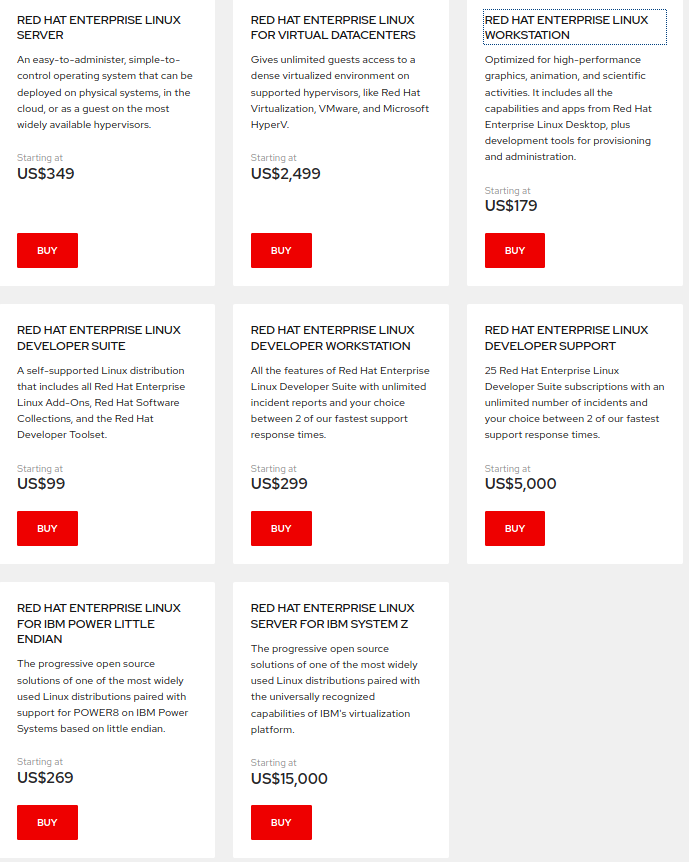imho: CentOS is a rock solid server operating system.
Why is CentOS perfect for servers?
- a server (usually) is build for a specific purpose and should have as little software installed as possible (more software = more reliability, speed and security problems, true for all OS)
- while CentOS also does a good job on workstations (was running CentOS7 for years on primary workstation) the massive amount and ease of installation of apt packages in Debian makes it “perfect” for client systems that will have a lot of software installed (browser, mail client, office… and many many more)
- under CentOS it is possible to compile and install the latest kernel with more ease than under Debian/Ubuntu
Fedora -> CentOS -> RedHat Linux
so… what are actually the differences?
“This is the second release of a new distribution from the CentOS Project: CentOS Stream.
CentOS Stream is a rolling-release Linux distro that exists as a mid-stream between the upstream development in Fedora Linux and the downstream development for Red Hat Enterprise Linux (RHEL).
It is a cleared-path to contributing into future minor releases of RHEL while interacting with Red Hat and other open source ecosystem developers.
This pairs nicely with the existing contribution path in Fedora for future major releases of RHEL.
You can read more on the CentOS Stream release notes page.”
They are all rpm based Linux distributions.
please correct if wrong: While Fedora is the bleeding edge – the “nightly build” – for the alpha testers (free) thus developers.
CentOS is for the beta testers (also free, not only for developers?).
imho: RedHat Linux is all that made it through alpha and beta test -> RedHat Linux
not so free: the 349€ per yer version does not come with customer support.
CentOS (/ˈsɛntɒs/, from Community Enterprise Operating System[6][7]) is a Linux distribution that provides a free, community-supported computing platform functionally compatible with its upstream source, Red Hat Enterprise Linux (RHEL).[8][9]
In January 2014, CentOS announced the official joining with Red Hat while staying independent from RHEL,[10] under a new CentOS governing board.[11][12]
https://en.wikipedia.org/wiki/CentOS
CentOS Governance
The CentOS Project governance structure has two main tiers:
- The Governing Board, a group of 8 to 11 people, responsible for overall oversight of the CentOS Project
- Special Interest Groups (SIGs), teams within the community that focus on either enabling a technology solution as an add-on to the core CentOS release, or building and maintaining a functional aspect of the Project, such as infrastructure or documentation.
The Governing Board is like a greenhouse, providing support for starting and maturing a SIG the way a greenhouse uses sunlight, water, nutrients, and soil to turn seeds in to fruiting plants.
The CentOS Governing Board
The focus of the Governing Board is to assist and guide in the progress and development of the various SIGs, as well as to lead and promote CentOS.
The CentOS Governing Board is the governing body responsible for the overall oversight of the CentOS Project and SIGs, the creation of new SIGs, and the election (and re-election) of new board members. The Board also has the responsibility to ensure the goals, brands, and marks of the CentOS Project and community are protected. The Board serves as the final authority within the CentOS Project.
Current Sitting Board
The initial CentOS Governing Board will be made up of members of the CentOS Project, many of whom have been around since the creation of the Project, as well as new members from Red Hat who were instrumental in bringing the new relationship together.
The CentOS Governing Board is:
- Carl Trieloff
- Free Seat
- Jim Perrin
- Johnny Hughes
- Karanbir Singh (Chair)
- Karsten Wade (Liaison)
- Mike McLean
- Ralph Angenendt
- Tru Huynh
More information
IBM bought RedHat: 34 billion bucks
Yesterday’s news: 2019 Mergers & Acquisition madness continues – IBM bought RedHat for $34billion
- “Competing in the cloud market
- Disappointment around the success of IBM Watson
- Catching up with Microsoft
- To help provide support for an important but struggling Linux organization”
src: https://hub.packtpub.com/4-reasons-ibm-bought-red-hat-for-34-billion/
- Jim WhiteHurst might become CEO of IBM? (src: https://www.bizjournals.com/triangle/news/2020/02/07/red-hat-ceo-jim-whitehursts-ibm-promotion.html)
https://www.zdnet.com/article/why-ibm-bought-red-hat-its-all-open-source-cloud-all-the-time/
Youtubes:
liked this article?
- only together we can create a truly free world
- plz support dwaves to keep it up & running!
- (yes the info on the internet is (mostly) free but beer is still not free (still have to work on that))
- really really hate advertisement
- contribute: whenever a solution was found, blog about it for others to find!
- talk about, recommend & link to this blog and articles
- thanks to all who contribute!




